Industrial Extraction Arms—a Practical Guide
breadcrumb >> list
Industrial Extraction Arms
Industrial processes such as welding, soldering, grinding, and chemical handling release harmful fumes and dust. If not properly captured, these contaminants can jeopardise worker health, damage sensitive equipment, and lead to costly regulatory issues.
Industrial extraction arms—also known as fume arms or source capture arms—offer a flexible, effective solution. These adjustable arms capture contaminants right at the source and direct them into filtration or exhaust systems. Easy to install on walls, ceilings, benches, or mobile units, they are widely used across industrial and lab settings.
This guide walks you through the benefits, common uses, key features, and what to consider when selecting an extraction arm system—along with recommended solutions that work in Canadian industrial environments.
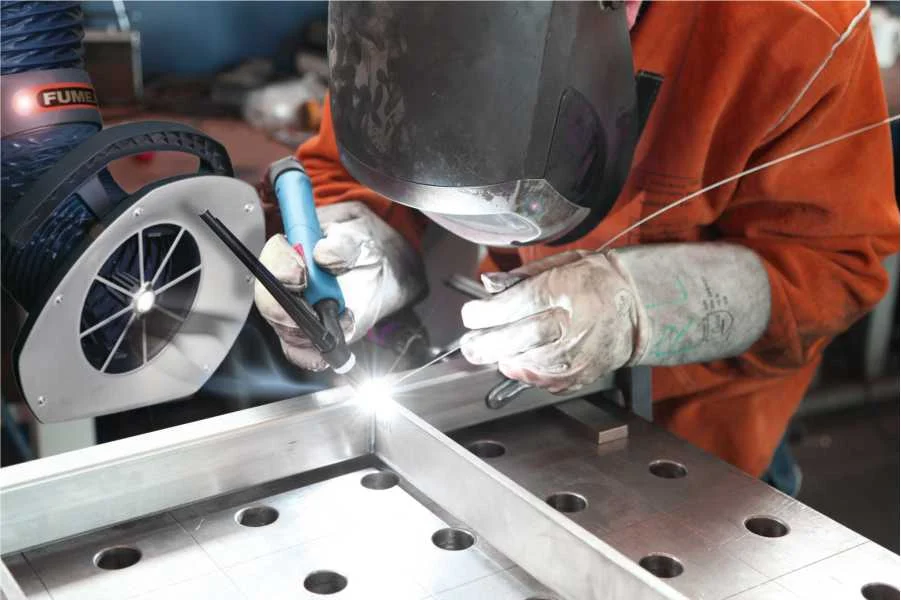
How Extraction Arms Work
Extraction arms are part of a local exhaust ventilation (LEV) system. A hood is positioned close to the emission source, and a fan creates suction that pulls contaminated air through the arm into a filtration system or outdoor exhaust.
This method is far more effective and energy-efficient than general room ventilation, as it removes pollutants before they can spread.
Common Applications
Welding & Metal Fabrication
Capture welding smoke, grinding dust, and fumes directly above the work area to protect worker health and equipment.
Soldering & Electronics Assembly
Ideal for flux fumes and fine particulates, especially in compact bench-top environments.
Laboratories & Chemical Handling
Arms remove solvent vapours and chemical gases safely, protecting both personnel and test results.
Pharmaceutical & Food Production
Sanitary-grade designs maintain air quality while meeting hygiene requirements in sensitive production zones.
Automotive & Maintenance Shops
Remove smoke and fumes during welding, cutting, or repairs in busy vehicle bays.
Educational & Training Facilities
Vocational centres benefit from flexible arms in welding booths and labs, protecting students while keeping air clean.
Why Use Extraction Arms
- Improved Worker Health
Extraction arms help remove harmful particles before they reach breathing zones. - Regulatory Compliance
Meets health and safety standards including OHSA and provincial air quality guidelines. - Energy Efficiency
Targeted airflow reduces the energy demands of large-scale ventilation systems.
-
Cleaner Equipment
Keeps dust and fumes away from sensors, electronics, and sensitive production areas. -
Productivity
Clear air and better visibility contribute to safer, more comfortable working conditions. -
Adaptability
Easily repositioned and stored, arms support varied tasks without interrupting workflow.

Key Features to Consider
- Mounting Configurations
Wall, ceiling, bench, or mobile bases—choose based on workspace layout and whether portability is needed. - Duct Diameter & Airflow
Common diameters range from 75 mm to 200 mm. Larger diameters handle higher airflow (CFM or L/s), required for dense fumes or large coverage areas. - Support Mechanisms
Look for stable, self-supporting arms with smooth movement and reliable joint tension.
- Material Construction
Aluminium, stainless steel, and flame-retardant plastics are typical. Anti-static and ATEX-rated options are available for explosive environments. - Integrated Controls
Manual dampers, start-stop switches, and smart sensors help optimise energy use and performance.

Purchasing Considerations
- Type of Contaminant
Understand whether you’re capturing vapours, smoke, dust, or particulates—and the associated health or safety risks. - Temperature & Chemical Compatibility
Select materials that are rated for heat or chemical resistance if required by your process. - Airflow Needs
Choose an arm and fan combination capable of delivering sufficient airflow to effectively capture contaminants. - Workspace Coverage
Ensure the arm’s reach covers the full working area. Consider any space limitations or ceiling height.
- System Integration
Ensure the arm integrates with your existing ducting, filtration, or fan systems. For centralised setups, airflow balancing may be necessary. - Ease of Use
Workers are more likely to use arms that are easy to manoeuvre and stay where placed. Prioritise ergonomic, stable designs. - Certifications
Look for CSA, ATEX, or other relevant certifications, especially in regulated or hazardous environments. - Maintenance Requirements
Simpler designs with accessible parts are easier to clean and service, reducing downtime.
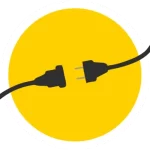
Integration Options
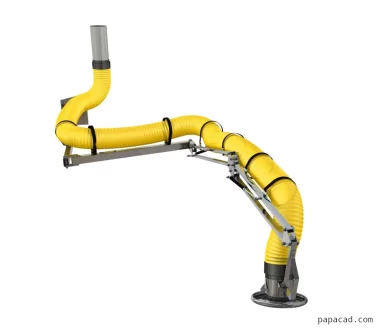
Standalone Units
Great for mobile or isolated tasks, these include a fan and filter system in one portable package.
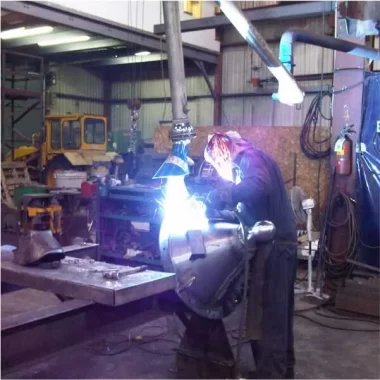
Central Systems
Multiple arms ducted to a shared fan and filtration unit—ideal for large or multi-station environments.
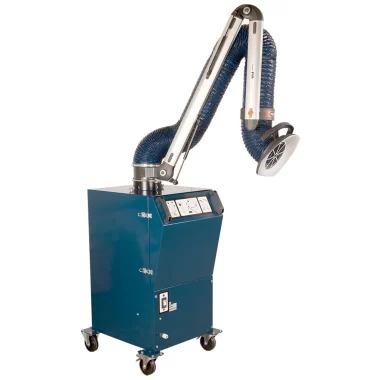
Filtration Choices
Depending on your process, choose HEPA filters, activated carbon, or multi-stage systems. Air can be safely vented outdoors or recirculated if permitted.
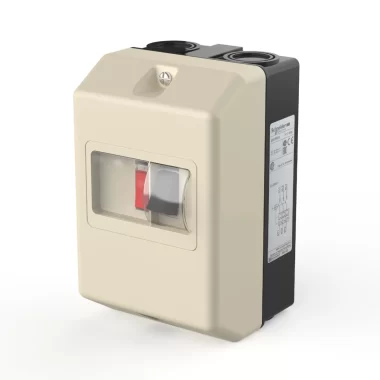
Smart Controls
Modern systems offer sensor-based automation, variable fan speeds, and remote diagnostics for better energy use and maintenance planning.
Why Choose Capt-Air Inc. and SonicAire?
Why Choose Movex Extraction Arms
When performance, reliability, and safety matter, Movex extraction arms stand out. Manufactured with exceptional attention to engineering and ergonomics, Movex products combine rugged design with ease of movement, precise positioning, and low maintenance needs.
Available in a wide range of sizes and materials, Movex arms are well-suited to Canadian industrial conditions—from welding and machining shops to laboratories and food production facilities. Whether you need chemical resistance, explosion-proof options, or ultra-smooth articulation, Movex offers a configuration built to perform day in and day out.
Your Canadian Supplier, Designer, and Installer
From concept to commissioning, Capt-Air delivers turnkey solutions for industrial extraction systems. As a trusted Canadian distributor and system integrator, Capt-Air supplies high-performance Movex extraction arms along with the expertise to design custom layouts, specify airflow requirements, and ensure full regulatory compliance.
Capt-Air’s experienced team handles system planning, installation, and post-installation support—including filter management, testing, and maintenance plans. Whether you’re upgrading a single workstation or fitting out an entire production line, Capt-Air ensures your extraction setup is efficient, compliant, and built to last.
Conclusions
Industrial extraction arms are an essential solution for maintaining air quality, ensuring safety, and improving operational efficiency in a variety of workplaces. By capturing fumes, dust, and vapours directly at the source, these systems help businesses protect their people, stay compliant, and operate more sustainably.
When selecting an extraction arm, consider your specific application needs—such as airflow, space constraints, contaminant type, and integration with existing systems. Prioritise ease of use, durability, and performance to ensure the system is actually used consistently and delivers value over the long term.
With ongoing innovations in smart control, energy efficiency, and ergonomic design, investing in a quality extraction arm is a future-ready move for any modern industrial facility.